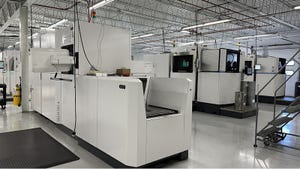November 24, 2010

A new all-plastic pallet design from Lomold features a high-strengthsystem whose top and bottom decks and optional components snap-fit into placeand can be removed when not needed.
The pallets are the first products to emerge from a newmolding technology developed in South Africa that combines the designcapabilities of injection molding with the strength provided in low pressuremolding systems.
The base of the new pallet concept can remain at aproduction plant or distribution center while product is transported on the topdeck of the pallet to a customer's facility, where it would then be placed onanother base.
When not in use, both top and bottom decks are nestable,greatly reducing the footprint needed to store or ship empty pallets. The newpallet weighs 30 lb compared to 88 lb for comparable alternatives, wood, plasticor plastic wood composite.
Lomold says the top deck can be used as a standalone palletfor one-way trips, yet it supports a dynamic load of up to 4,400 lb.
"There have been many attempts over the past few decades todevelop a plastic or composite pallet that eliminates the traditional issues ofwood - such as high weight, inconsistent dimensions, short use-life, highmaintenance and washability," says Pieter du Toit, Lomold Group founder and CEO.
The components are produced from the company's patentedlong-(glass) fiber thermoplastic (LFT) injection-molding process using polypropylenecomposite. Glass loading is 36 percent by weight. Lomold won a JEC compositesaward earlier this year for its one-piece pallet produced with the new moldingprocess.
The new pallets can be washed for increased hygiene due tothe composite's hydrolytic stability. No fumigation is required.
Although the capital cost of the LFT pallet system can bemuch higher than wood, Lomold says operational cost savings plus utilizationbenefits more than compensating for the higher initial cost.
Lomold calls its new processing technology "3-D LFT" becauseit combines the three-dimensional design benefits of injection molding with themechanical properties for glass fibers found in direct molding processes suchas compression molding. The glass fibers are much longer in the finishedcomponent, up to 50 mm versus just 5 mm even in complex shapes.
Du Toit says the only major difference between Lomold'sprocessing machines and traditional injection molding machines is the waymolten material is injected into the closed mold.
The 3-D LFT Machine uses a series of pistons in place of ahot runner system to move material from a barrel to a mold cavity. The finalpiston face becomes the final boundary face of the mold cavity. This allows thegate size to be increased up to 100 mm without the requirement to cool a sprue.
This avoids breakage of fibers that occurs when the melt isforced under high pressure through check valves, hot runner systems and gatesin a traditional injection molding system.
The Lomold group selected pallets as the first product to becommercialized with the new technology and it was introduced at Pack Expo inChicago and K 2010 in Düsseldorf, Germany.
The machinery for Lomold is being built by Chuan Li FaMachinery Works Co. of Yuen Kang City, China. A U.S. patentissued to Lomold in 2005 indicates the technology could also be used to moldceramic and glass components.
Lomold is building a new pilot plant in China that will beable to produce 25,000 metric tons of material next year and 60,000 metric tonsin 2012.
Click here to see avideo of how the new molding technology works.
About the Author(s)
You May Also Like






